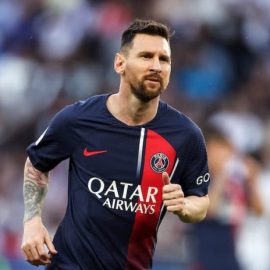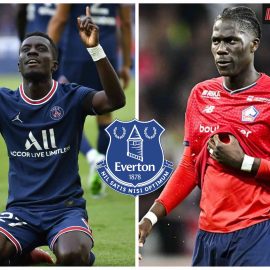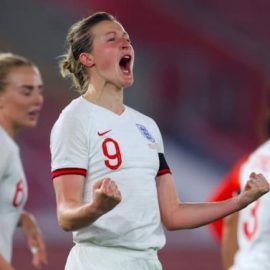Twenty-two minutes isn’t long. Yet who knows how precious those short moments were to Ronaldo, finally back on a football pitch last week in Corinthians’ 2-0 cup win over Itumbiara. After a year spent wrestling with the aftermath of more surgery and rehabilitation, and with the hurried panting of time becoming almost as loud in his ear as his own laboured breaths, it was almost as if the moment had been stolen, as if the hourglass had been laid to one side for half an hour or so for the frenzied distractions of a São Paulo night.
Because immobile and disconnected as he was, Ronaldo’s comeback was already easily better than some of his previous efforts. Most famously, in what would become a tragically recurring image for the rest of his career, it took only seven minutes for his knee to buckle on his return for Internazionale in the Coppa Italia final against Lazio in April 2000 after six months out. In fact, his debut appearance for Corinthians was by far the most successful comeback of the week.
The rise and fall of ‘The Cobra’
Just like Ronaldo, Adrian Ilie was once a player with high expectations. Emerging from the misty southern plains of Romania with his now-defunct hometown club Electroputere Craiova, Ilie signed for Steaua Bucharest for what was then a record Romanian deal of around $100,000 at the age of 19. During his time with the army club he dispatched 28 goals in 85 league matches, and made the first of 55 appearances for the national side. But the world was calling.
A brief stop-over at Galatasaray was followed by the move in 1998 which was ultimately to define his career. In four years at Valencia Ilie became ‘The Cobra’, a lithe assassin of exceptional movement and grace, a coiled penalty-box menace of whom defenders could never be sure if he was truly sleeping. A domestic strike rate of one in three was capped by a 70th-minute substitute cameo in Valencia’s Champions League final appearance in 2000. Sadly, he had succumbed to persistent injury before their second, equally unsuccessful shot at the trophy the following year. Never again quite the player of old following his recovery, a 28 year-old Ilie was released from his contract in 2002.
That was pretty much that. Ilie spent the following season stumbling through the truly monstrous post-UEFA Cup run hangover which saw Deportivo Alavés relegated from the Spanish top flight, before returning to Istanbul with his compatriot Mircea Lucescu’s BeÅŸiktaÅŸ. If his star briefly flickered again, with six goals in thirteen games, it was because it was rapidly being extinguished.
He moved once again, this time to the resolute obscurity of FC Zürich, where his wrecked ankle ligaments finally called a halt on May 11th, 2005. Although he signed a further deal with Germinal Beerschot later that year, he failed to play a single game in Belgium. Finally accepting his fate, Ilie slowly walked away from the game that had been his life since those distant days at Electroputere to a new life running a Transylvanian ski hotel. Gheorghe Hagi – despite hailing from outside the Black Sea port of ConstanÅ£a – had became famous as the Maradona of the Carpathians. Ilie, the only talent who, in recent years, has even come close to Hagi, seemed content to fade from the public eye amongst those same mountains.
A new lease on life?
Enter Terek Grozny. Ten days ago, the Chechen side, preparing for a second straight season in the Russian Premier League, announced that they had offered Adrian Ilie, now retired for almost four years, a contract. As Ilie himself explained: “The officials from Terek called me a few months ago, but I told them that I could not play. It has been a long time since I gave up football. However, they insisted so much and they managed to convince me. I will go to Germany to do some medical checks and, if everything is OK, I will sign the contract”. Terek vice-president Haidar Alhanov, addressing a somewhat bemused media throng, declared that: “So what if Ilie is 35 years old? [Amadeo] Carboni played at Valencia until he was 40 and he played very well. If a player is dedicated to what he does, age doesn’t matter”. The deal was reported to be worth €1.2 million to Ilie, with whom the Chechens didn’t exactly play hardball in negotiations: “The officials from Terek wanted me so much that they were ready to offer me an unfilled contract. I could write the amount that I wanted”, he confessed.
Really? Why would a 35-year old player, forced to retire through serious and persistent injury, be offered such a bumper contract after four years of inactivity? It appears that Terek could have had little expectation of Ilie actually making any significant contribution to the new Russian season, which kicks off later this month, given his admission that: “At the beginning, I will only play five to ten minutes. Then we’ll see. The most important thing is that my feet can take it”. Terek, to judge by their enthusiasm to get Ilie signed up, clearly believed that they could.
Then, last week, the results of Ilie’s medical tests in Germany arrived. Belief can sometimes seem very small when compared to science. There was no way his shattered ankle would be able to withstand a comeback of any description. Ilie, by now thoroughly attuned to the impositions of medicine, was admirably philosophical: “When I decided to retire from football I knew why I had taken that decision. The officials from Terek asked me to play a few minutes of every match, but I couldn’t accept this. I don’t want to complicate the situation or create problems in the locker room”. The outcome, for all the excitement generated by the prospect of his return, was hardly a surprise. So what had really been going on here?
Behind the curtain
Several possibilities spring to mind. Firstly, Terek have recently developed a fascination with Ilie’s countrymen. An indifferent start to last season saw the Chechens sign three Romanians on a single day in July 2008, and Andrei Mărgăritescu, Daniel Pancu and Florentin Petre were generally — if not entirely accurately — credited with single-handedly stabilizing Terek’s season and guiding them to a tenth-place finish.
With this narrative becoming the sole currency at the club, perhaps Terek had genuinely come to believe in the redemptive powers of Romanian footballers, to the exclusion of all others and of common sense. Moreover, if anyone knows anything about comebacks, it’s Terek Grozny. The club spent almost twenty years either disbanded, under threat of demotion, or playing outside their home city.
Terek were always a hot potato even before the first and second Chechen wars, with matches against Moscow sides, allied with the local practice of spectators firing rifles into the air to celebrate goals, an enduring source of consternation. Their years in exile in Pyatigorsk were lonely ones, where the city’s inhabitants would often turn up specifically to cheer on the opponents to the hated separatists, and their home Sultan Bilimkhanov Stadium was the scene of the assassination of Chechen President Akhmad Kadyrov in 2004. So consecutive seasons in the top-flight, with a return to Grozny and — most unusually for Russia – a decent playing surface, are certainly quite the achievement. If the club could make it back to the top, so the argument runs, then Ilie would have had every chance.
A charitable interpretation would probably take such a form. Whether such an interpretation would be plausible is another question. More likely is the depressing suspicion that Terek knew full well that Ilie would never pass any medical worthy of the name, and were simply using him as a means of garnering cheap publicity.
The reactions which the club met in Pyatigorsk still prevail across much of the country, with major security operations still required for most away games. In return, sides visiting Grozny last season stayed under armed guard in a compound sixty miles from the city. Some positive headlines in the wider Russian press would, without question, be a welcome change. There is also the additional factor of Terek’s new-found following in Romania, established as a result of last season’s triple signing, which could conceivably have motivated one crowd-pleasing gesture too many.
The hope is that Terek’s motives were sincere. To this observer, the key detail is probably the reported size of the contract, which seems so totally disproportionate as to suggest that they were confident of never needing to deliver on it. If so, the saga reflects pretty shabbily on the club, who thus appear prepared to play fast and loose with a man’s innermost feelings and dreams for the sake of a few extra lines of newsprint. Ilie’s words when the story broke carry a real melancholy: “Over my career, I have made enough money to lead a peaceful life. But I gave everything for football and maybe this is why football did the same for me. I have been convinced that this chapter is not yet over for me. Why wouldn’t I try again? I want to smell the grass again”.
Who can doubt that similar thoughts are what drive Ronaldo, however ineffectively, back to the gym after each crippling injury? At least he has smelt that grass one more time, and is now saying his slow goodbyes. No such luck for Ilie. Terek Grozny played the old music and the Cobra came dancing. Dancing on one leg, perhaps, but dancing none the less. He deserved better.
Add Sportslens to your Google News Feed!






